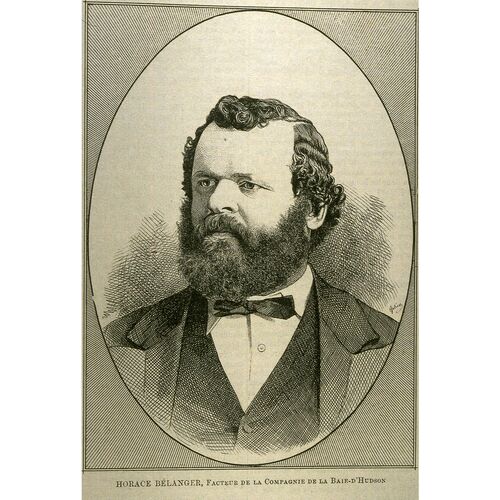BÉLANGER, HORACE (baptized Édouard-Horace), fur trader and jp; b. 11 June 1836 in Rivière-Ouelle, Lower Canada, son of Édouard Bélanger and Marie-Sophie Casgrain; m. 27 Aug. 1861 Rosalie Marion in St Boniface (Man.), and they had 11 children; d. 1 Oct. 1892 in Sea River Falls (Man.) on the Nelson River.
Horace Bélanger’s mother was linked to many prominent French Canadian families. She was the daughter of businessman and seigneur Pierre Casgrain*; the eldest son of her first marriage, Horace’s half-brother Luc Letellier* de Saint-Just, became lieutenant governor of Quebec. Horace’s father, a successful businessman engaged in the whale hunt, joined the Hudson’s Bay Company in 1853 at the rank of chief trader to inaugurate a whale fishery at Little Whale River (Petite Rivière de la Baleine, Que.), but drowned there that year.
Horace had entered the commercial course at the Collège de Sainte-Anne-de-la-Pocatière in February 1849 and attended until July 1851. Two years later he began his career with the HBC as apprentice clerk at Sault Ste Marie (Ont.). Chief Factor James Hargrave*, in charge there, took the young man under his wing. Speaking only French at first, Bélanger soon learned to speak and to write in English and to converse in Cree and Ojibwa.
After service at Michipicoten (Michipicoten River) from 1855 to 1857, Bélanger was promoted clerk in 1858 and stationed at Fort Albany. In 1860 he transferred to the Lac La Pluie district, an area of competition with free traders. There he displayed the necessary initiative and endurance to counter any opponents, despite his massive bulk, for he was a “great burly man with jet black curly hair, full beard and must have weighed over 300 pounds.”
In 1867 Bélanger moved to Cumberland House (Sask.), where again the company faced the threat of free traders. As clerk in charge at Fort-à-la-Corne in 1868–69, he supervised the summer boat brigades, the vital transportation link between Cumberland House and its northern posts. In 1870, still a clerk, he took charge of the entire Cumberland district. Two years later he was promoted chief trader and in 1873 he was made factor.
HBC posts and personnel continued to dominate the northwest even after the transfer of Rupert’s Land to the Canadian government, and prominent officers such as Bélanger were appointed justices of the peace. Bélanger, who witnessed the consequences of treaties and white settlement for both the Indians and the Métis, insisted that the government provide some relief for those in desperate need and took the initiative himself in emergency situations.
In 1885 Bélanger had to make arrangements for alternative transportation when the government forces under Frederick Dobson Middleton used the HBC steamboats to move troops and supplies into the Saskatchewan area during the North-West rebellion. Bélanger also provided food for several destitute refugees from Fort-à-la-Corne and attempted to keep the Métis and Indians in the Cumberland district from joining the uprising. In the fall of 1885 he assumed charge of the Saskatchewan district as well as that of Cumberland. These strenuous efforts, for both the HBC and the people of his district, earned him the esteem of the Cree and Métis and warranted his promotion to chief factor in December. He thus had reached the heights of the HBC administration, the only French Canadian to attain that rank in the 19th century.
In 1889 Bélanger was transferred to Norway House (Man.). While there, he was appointed justice of the peace for the Keewatin District and served until 1892. A widower since 1887, he planned to resign from the HBC in 1893 to make a home for his children. Before he could do so, however, he drowned at Sea River Falls during his 40th year of service. Bélanger had always feared such a death; strangely, his father, his brother, and two of his sons had also drowned.
The Indians of Cumberland House and Norway House felt a great sense of loss at the demise of “one of their greatest and most generous benefactors.” These sentiments were shared by Bélanger’s fellow officers, who placed a large stone monument at Norway House as a memorial to him.
ANQ-Q, CE3-1, 11 juin 1836. PAM, MG 7, D8, reg. des mariages; MG 12, B; E; HBCA, A.12/Ft, 340/1; B.49/b/7, 10–11; B.49/e/1; B.135/g/42; B.154/k/1; B.239/c/18; B.239/g/39–40; B.239/k/3–4. Daily Free Press (Winnipeg), 24 Oct. 1892. Le Manitoba (Winnipeg), 26 oct. 1892. L’Opinion publique, 15 mars 1877. Winnipeg Daily Tribune, 27 Oct. 1892. Catalogue des anciens élèves du collège de Sainte-Anne-de-la-Pocatière, 1827–1927, [François Têtu, compil.] (Québec, 1927). Répertoire des mariages de Rivière-Ouelle, 1672–1972, troisième centenaire, Armand Proulx, compil. (La Pocatière, Qué., 1972). “The Belanger monument,” Beaver, outfit 261 (March 1931): 177–78. L.-A. Prud’homme, “M. Horace Bélanger, facteur en chef de la Compagnie de la Baie d’Hudson,” Rev. canadienne, 27 (1891): 464–68.
Cite This Article
Bruce Donaldson and Martha McCarthy, “BÉLANGER, HORACE (baptized Édouard-Horace),” in Dictionary of Canadian Biography, vol. 12, University of Toronto/Université Laval, 2003–, accessed January 21, 2025, https://www.biographi.ca/en/bio/belanger_horace_12E.html.
The citation above shows the format for footnotes and endnotes according to the Chicago manual of style (16th edition). Information to be used in other citation formats:
| Permalink: | https://www.biographi.ca/en/bio/belanger_horace_12E.html |
| Author of Article: | Bruce Donaldson and Martha McCarthy |
| Title of Article: | BÉLANGER, HORACE (baptized Édouard-Horace) |
| Publication Name: | Dictionary of Canadian Biography, vol. 12 |
| Publisher: | University of Toronto/Université Laval |
| Year of revision: | 1990 |
| Access Date: | January 21, 2025 |



